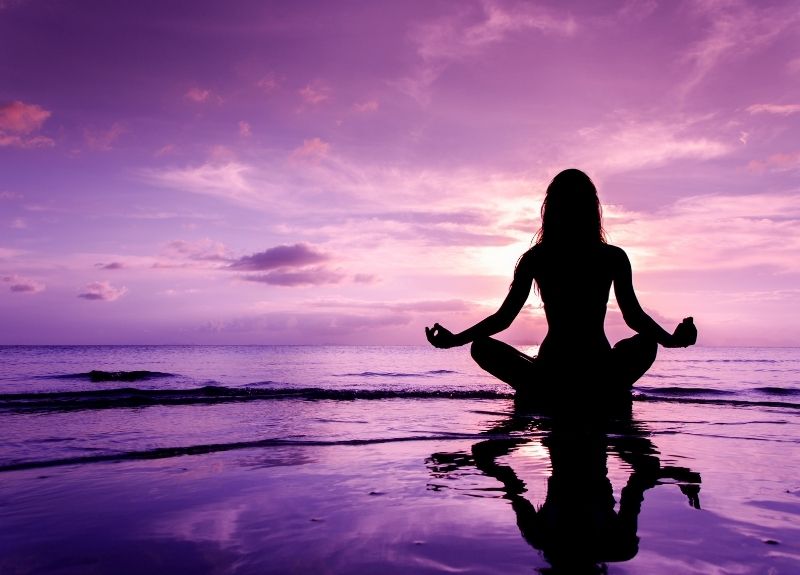Today, the practice of meditation is everywhere. It’s in our schools, modern workplaces, local gyms, and even on our phones.
Between 2012 and 2017, the use of meditation by adults in the United States more than quadrupled (from 4.1 percent to 14.2 percent) and increased each year.
The world is stressful, and people are more open to finding new ways to handle that stress.
If you are new to meditation and are thinking about trying it out, this article is for you. Read on to learn the basics and how to start as a beginner.
 What is Meditation?
What is Meditation?
Meditation is a practice that trains your mind. People employ a specific type of meditation to train their minds to pay attention and be more physically and mentally aware. This is done to attain a cognitively clear, emotionally peaceful, and stable state of mind.
People have meditated for thousands of years. Records show that the practice of meditation started around 1500 BCE. It appears to begin in India as a component of early Hindu tradition. It was later found as a component of Buddhist teachings in India and Chinese Taoism over a thousand years later, and Philo of Alexandria and Saint Augustine are noted to have brought the practice of meditation to the Western world.
Meditation was initially intended to aid in the more profound comprehension of life’s divine and mystical energies. The Hindus believed that meditation was a way to commune with God. The Buddhists believed that we could better understand how everything in the world is connected to each other through meditation.
However, today the practice of meditation is more widely used to help aid in relaxation and reduce stress. In addition, people of all ages, ethnicities, and spiritual backgrounds use it as a tool to help improve their overall mental health.
Meditation can be performed by anyone, anywhere, and at any level. You can do it alone in a quiet place, in a group of other people doing the same thing or fitting it in during a commute or while out for a walk.
The most important thing to know is that there is no wrong way to meditate. Find whatever way works best for you and enjoy the many benefits this mental exercise can bring you.
 What Are the Different Types of Meditation?
What Are the Different Types of Meditation?
There are many different types of meditation. Some are for the more disciplined, but all can be mastered. Here are a few of the most popular forms:
- Guided Meditations – Meditation is done under the guidance of a trained practitioner or by utilizing imagery, music, or voice through audio or video.
- Mantras – Meditation that uses a sound, word, or phrase on repeat to help you focus and enter a deep state of meditation.
- Mindfulness Meditation – A form of meditation that focuses on being aware of your breath with the intent of increasing positivity and awareness of your thoughts, bodily sensations, and the surrounding environment.
- Qigong – A type of meditation where the body is in motion through a physical exercise involving fluid movements that teach control over your body and breath.
- Tai Chi – A Chinese martial art form initially used for self-defense but can be utilized as a type of meditation similar to Qigong.
- Transcendental Meditation – Similar to mantras, it is a specific form of silent mantra-like meditation. It is part of the Transcendental Meditation movement created by Maharishi Mahesh Yogi.
- Yoga – A popular form of exercise that also requires you to focus your mind while performing intentional movements and controlling your breath and thoughts.
Almost all types of meditation have four key elements.
- A quiet space or a location with as few distractions as possible
- A comfortable place to sit, lay down, or walk.
- The ability to focus your attention either through humming, chanting, or concentrate on your breath or an object in your line of vision.
- An open mind
No matter which type of meditation you decide to try, they all share the same goal: To bring you inner peace through the practice of opening your mind, becoming self-aware, and focusing on positive energy.
Benefits of Meditation
Meditation has a long history of providing evidence that it can improve your mind, body, and spirit in many different ways.
The mental benefits of meditation can include:
- Gaining techniques to quiet your mind and calm your anxiety in stressful situations
- Increasing your ability to be self-aware
- Learning how to focus on the present moment and your surroundings
- How to identify negative thoughts and emotions and learning to let them go.
- Increasing your ability to be patient and tolerant of others
- Making it easier to tap into your imagination and creativity.
Through medical research, there has documented evidence that meditation could potentially help with the following medical conditions:
- Alcohol Addiction
- Age-Related Memory Loss
- Anxiety
- Asthma
- Cancer
- Chronic pain
- Depression
- Heart disease
- High blood pressure
- Irritable bowel syndrome
- PTSD
- Sleep problems
- Tension headaches
 How Do I Meditate As a Beginner?
How Do I Meditate As a Beginner?
First off, it’s essential to realize that meditation is for everyone. Anyone can use meditation, and the way you meditate can be as casual or complex as you want it.
If it’s your first time and you need something to point you in the right direction, use the following steps to help guide you:
Step 1: Decide which type of meditation you want to try. A simple guided, mindfulness, or mantra technique is a good place for beginners to start.
Step 2: Decide where and when you want to try. You can meditate in a quiet place, in a group setting, or out in public. However, it’s recommended to try in a quiet place that has as few distractions as possible for your first time. Someplace where you will feel at peace and not self-conscience.
Step 3: Decide how long you want to meditate. If you are doing a guided meditation, that step is done for you. However, if you are trying a mindfulness or mantra technique, you will need to figure out how long your session should be. It can be as short as 1 minute or as long as 20. On average, 5 minutes is an excellent place to start, and you can gradually work your way up to longer sessions as you feel comfortable.
Step 4: Begin the session. Almost all meditation techniques start by focusing on your breathing. This helps to bring your focus inward and allows you to connect with your physical body mentally. During this process, it’s good to acknowledge any physical tension and mental concerns you might have and then let your mind release them as you focus on your breathing. If you find your mind wandering during the session, gently refocus your thoughts to your breathing or mantra.
Step 5: Finish your session with a positive thought or intention and ground yourself. When doing a meditation technique that doesn’t require movement, it’s good to end with a relaxing stretch to bring movement back into your body.
Whether you are a beginner or master with meditation, you can’t deny the ease and benefits it can bring to your life.
Final Thoughts
If you’ve been thinking of trying it but haven’t felt comfortable taking the leap, I hope this article helped you realize that anyone can do it in any form they feel satisfied with. You don’t need any special equipment. However, you need to have an open mind and the willingness to connect with your body and the world around you.





No Comments